The Best Brush Pens For Lettering: 13 Must-Haves
We may earn a small commission for purchases made through affiliate links in this post. For more information go to our Privacy Policy.
Have you been searching for the perfect brush pen to use in your hand lettering practice? Just looking at a large number of different brush pens at the store can make your head spin and leave you wondering which one is the best! So, I’ve compiled a list of the best brush pens for lettering to help you get exactly what you want.
Hand lettering doesn’t require a lot of supplies to create beautiful art. All you really need are brush pens and paper, along with some patience and willingness to practice your skills.
But what brush pens and paper do you need? Does it matter? (actually, it does, and I’m spilling the beans below!)
I first began hand lettering to add beautifully written art to my bullet journals. Like many beginners, I had no idea what I was doing at first, so I hopped on the internet and did a search for brush pens.
Not Knowing Where To Start
I remember feeling so excited to pick out my first set of brush pens and get started on building my hand lettering skills. When the search results populated, my excitement vanished. There were too many options!
I had no idea where to begin with choosing my new pens, so I just ordered 3 or 4 different types and hoped I would like at least one of them. As it turns out, I did end up liking a couple of them, and the others just ended up getting lost in the black hole of my junk drawer.
Since I had no idea what features to look for or which ones I would even want, I didn’t know which ones to gravitate towards or stay away from. However, with some practice and experimenting, I did learn which features mattered and which ones I liked.
Today, I want to help make the process easier for you by giving you the information I wish I had when I was buying my first brush pens!
I’m covering everything you need to know about brush pens and even giving you a personally vetted list of the best brush pens for hand lettering to save you time and prevent confusion.
Brush Pen Features To Consider
When I started my hand lettering journey a few years ago, a few pen options were available. However, since this art form’s popularity has exploded over the past few years, it’s fueled a similar explosion in the range of brush pens available on the market.
What once was 8 or 10 options has expanded into dozens, which can be a bit overwhelming for beginner hand letterers!
Over the years, I’ve tried using many different brush pens, often trying new brands or models as they came out. So it’s safe to say that I’ve learned a LOT about them and what features make a pen one of the best brush pens.
Let’s remove the mystery and confusion for you by going over some characteristics of different brush pens. I don’t want to just jump into a list of brush pens because you will face the same problem I had: knowing which features matter when choosing a pen.
When we take brush pens to basics, we discover that they all share one similar feature: a flexible nib that helps you create thick and thin strokes in your letters.
But that’s where the similarities end because pens vary widely in nib size, material, hardness, and more. Since every land letterer has different preferences, I need to go over the differences so that you can use the information to pick pens.
These pen features will impact how your lettering looks and how you connect with the pen. When you start looking for brush pens to buy, consider these features.
Brush Pens Tip Material
Believe it or not, brush pen tips can vary according to the material used to construct them. You’ll typically find three different types:
- Felt tips – these have a plastic base and are firmer, so they don’t need as much effort to control them to get beautiful, consistent lines.
- Synthetic tips – made of nylon and mimic brush strokes but are easier to handle.
- Bristle tips – these tips closely mimic the behavior of a natural brush and are made of sable or weasel hair. These tend to be high-end pens. My recommendations will focus on felt tips and synthetic tips.
Tip Size
Tip (nib) sizes can range from small (fine) to large (broad). Nib size differences determine how wide you can make your strokes. You may prefer to work with one size in general, or you may choose to change it up based on the project.
Tip Hardness Of Brush Pens
A nib’s hardness will factor into line variation. You’ll see a more significant difference between stroke thicknesses with softer tips, but they require more control to create consistent, beautiful strokes. Firmer nibs will require more pressure (but less control) to produce good line variation.
Bristle tips fall into the soft category, while synthetic and felt tips are firmer.
Tip Elasticity
This feature refers to the nib’s ability to retain its original shape after each stroke. A tip with good elasticity will immediately bounce back to its original shape. Synthetic and felt tips usually have good elasticity, while bristle tips fan out and require reshaping after each stroke.
Brush Pens Ink Flow
The ink flow is a measurement of how much ink a brush dispenses when pressure is applied. You’ll find brush pens labeled with ink flow labels of heavy (aka, wet), medium, or dry.
Heavy ink flow tips release more ink and produce consistent lines, but they can create ink splotches if you write slowly or apply a lot of pressure.
In contrast, dry tips can create lines with uneven ink distribution, which might be an effect you want in specific applications!
Color Options
Brush pens range from offering only black ink to a varying number of different colors.
Choosing Brush Pens: Notes And Tips
In addition to considering the characteristics I just mentioned, here are a few other tips that I’ve learned through experience which can help you make your final choices.
- Consider color options – most hand letterers like to use their skills in various applications, and many of those benefit from using a variety of colors. If you want to use color, I recommend looking for pens with a wide range of options – say, at least 20 colors.
- Quality – buying cheap pens that fall apart the first time you use them is a complete waste of money. Consider paying a little more for high-quality products that get good reviews.
- Non-toxic ink – why add more toxins to your life? In addition, if you have kids, it’s better to be safe than sorry in case they get into your brush pens when you aren’t looking.
- Washable ink – trust me, if you have kids, you’ll be thankful you bought washable ink!
- Try different nib sizes – you may think you prefer one tip size over another, but you really don’t know until you try them both. I recommend buying one fine tip and one broad tip so you can play around with them in different applications to see which you like better.
The Best Brush Pens For Hand Lettering
Let’s get to the fun part! I’ve gathered a list of the best brush pens I recommend for all levels of hand lettering. NOTE: I’m not suggesting you buy all of these pens. My goal was to provide great options for all your hand lettering needs and preferences.
1. Crayola Markers
Crayola markers are always one of my top recommendations whenever I talk with beginners because they’re easy to find, durable, and affordable. Plus, they have excellent ink flow, a variety of tip sizes, and you don’t need to use any special paper with them.
[amazon box=”B003HGGPLW”]
Crayola markers are very long-lasting when stored with the caps on tightly, and their ink is washable and non-toxic.
NOTE: Crayola markers aren’t actual brush pens, but I include them on this list because they produce brush pen-like results. You will need to adapt your technique slightly to use them because it’s more about adjusting your hold to use the tip angle effectively than it is about the pressure.
- Tip material – they have felt tips.
- Tip size – both small and large, depending on the angle you hold the marker and the pressure you use.
- Hardness – they don’t have a flexible brush tip or a nib. You create line variation by changing the angle of the marker.
- Elasticity – these tips never lose their shape.
- Ink flow – they have medium-heavy ink flow, so you’ll get consistent lines.
- Color choice – there are lots of color choices (40+).
2. Tombow Dual Brush Pen
There are many reasons to love the Tombow Dual Brush Pens! That’s probably why they’re one of the most trusted and recommended tools for hand letterers and calligraphers!
I could go on and on about these beginner-friendly pens because I love them. The “pros” column is filled with points such as non-toxic, water-based ink that’s very blendable, two standalone tips, and an included colorless blending brush pen to help blend colors and create fun writing effects.
[amazon box=”B00JVB8FBA”]
The second tip is fine and firm, and you can use it as a standalone pen or make corrections to your writing from the other end.
Drawbacks for these brush pens include the likelihood of fraying if you don’t use the right paper and the cost. These pens are not cheap, so I recommend using the right kind of paper to help them last as long as possible!
- Tip material – one synthetic and one felt.
- Tip size – one large brush and one fine tip.
- Hardness – the long brush tip creates smooth thick and thin transitions with plenty of variation between the two.
- Elasticity – two self-cleaning tips, one long and elastic, and the other firm.
- Ink flow – they have medium-heavy ink flow.
- Color choice – an unbelievable number of color choices (108!).
3. Sakura Pigma Professional Brush Pen
These brush pens stand apart from the crowd for a variety of reasons. They’re sold in a pack of three different sizes (fine, medium, and broad) and have short flexible tips for easy handling. The tips are great for beginners because they have just the right level of responsiveness to create a smooth and enjoyable writing experience.
[amazon box=”B00RGFVXPI”]
I have a few things to note regarding these pens: Sakura developed the special ink in these pens. It’s waterproof, doesn’t smear, and won’t bleed on most types of paper. Since it’s a brush tip, I do recommend using a smooth kind of paper. The ink is permanent, so it might not be a great choice in a house with small kids.
One other thing: this pen ONLY comes in black. If you want a pen with a variety of colors, this one isn’t it.
- Tip material – synthetic brush tips.
- Tip size – the pack comes with fine, medium, and bold tips.
- Hardness – the long brush tip creates smooth thick and thin transitions with plenty of variation between the two.
- Elasticity – soft to medium-firm elasticity.
- Ink flow – medium flow using unique archival Pigma ink.
- Color choice – only available in black.
4. Pentel Fude Touch Brush Pen
If you’re searching for a new fine tip brush pen to love, the Pentel Fude may be precisely what you want.
[amazon box=”B009UVI2PU”]
These popular brush pens are ideal for smaller fonts and projects. The tips are very durable (they last SO long) and work well on cheaper paper without fraying. You can get 12 different colors, and the ink is water-based so that you can blend colors.
- Tip material – felt tips.
- Tip size – fine tips.
- Hardness – the fine tip provides minimal to medium variation between thick and thin strokes.
- Elasticity – flexible tips that don’t require a lot of pressure and return to their original shape.
- Ink flow – medium flow ink.
- Color choice – 12 colors available: black, red, sky blue, violet, yellow, blue, green, brown, orange-yellow, gray, pink.
5. Tombow 61500 Twintone Marker Set
Tombow is both well-known and trusted in the brush pens world. These markers are double-sided so that each marker gives you a fine tip and a broad tip. Brushes will lose their form over time, but the fiber tips in these brush pens are long-lasting.
[amazon box=”B075MM5NGM”]
The ink is water-based and dries quickly to help prevent your hard work from smudging. And the tips are so durable that they can be tough on paper, so I recommend using thicker paper.
- Tip material – felt tips.
- Tip size – extra fine and broad tips.
- Hardness – line variation differences will vary between the tips.
- Elasticity – hard tips that require more pressure.
- Ink flow – medium-heavy flow ink for consistent lines.
- Color choice – 12 colors available.
6. Ecoline Brush Pen
These brush pens are incredible! They have very flexible tips that create fun, bold strokes and a heavy flow of watercolor ink that allows you to develop drool-worthy ombre effects. And if all that wasn’t enough, the pens are blendable, and you can re-wet them if they dry out.
[amazon box=”B077JYNLYW”]
But perhaps my favorite feature of these pens is the eco-friendly (and wallet-friendly!) ability to refill the ink and use them again and again, so you don’t need to buy new pens.
- Tip material – nylon fiber brush nibs.
- Tip size – large tips.
- Hardness – line variation differences will vary between the tips.
- Elasticity – very soft and flexible tips which require more control and make it challenging to achieve consistent medium strokes.
- Ink flow – heavy flow ink for an ombre effect.
- Color choice – 10 vibrant colors available.
7. Sakura Koi Brush Pens
These beginner-friendly brush pens are a top competitor to Tombow’s brush pens. They’re fun to use, thanks to their vibrant colors and bold brushstrokes. Have fun with blending the watercolor ink.
[amazon box=”B0074HJL0W”]
These tips can fray quickly if you don’t use the correct type of paper with them. To keep them in tip-top shape for as long as possible, avoid using printer paper and other types of rough paper that can cause the tips to fray.
- Tip material – synthetic nibs.
- Tip size – medium-large tips.
- Hardness – tips spring back to shape quickly, creating large differences between thick and thin strokes.
- Elasticity – medium-firm elastic brush tips.
- Ink flow – heavy flow ink creates an ombre effect.
- Color choice – 48 vibrant colors available.
8. Karin Brushmarker
When you’re searching for responsive nibs, excellent elasticity, and vibrant ink flow, put these Karin Brushmarkers on your short-list of possibilities! The brush pens use non-toxic “liquid ink” technology and are fully blendable with all colors.
[amazon box=”B07F1DTF1F”]
Due to the heavy ink flow from these brush pens, I recommend using thicker watercolor paper that’s capable of absorbing the extra ink.
- Tip material – nylon brush tips.
- Tip size – large nibs.
- Hardness – tips spring back to shape quickly, creating great variation between thick and thin strokes.
- Elasticity – soft-medium elastic brush tips that create bold strokes and smooth transitions.
- Ink flow – heavy flow ink for beautiful wet lettering.
- Color choice – 60 vibrant colors available.
9. Tombow Fudenosuke Brush Pen
I flirt with other brush pens from time to time, yet I come back to Tombow pens every time. These particular pens are extremely popular thanks to the ease at which beginners can use them. They strike an ideal balance between affordability, durability, and easy handling.
[amazon box=”B01M71S9DU”]
Each pen comes with a hard tip and a soft tip, and writing with each one produces a noticeably different experience. The tips are more durable than the Tombow Dual Brush Pen.
Remember, no matter what brush pens you use, they almost always last longer if you use good quality (smooth) paper.
But one of my favorite features is that the pen is made from recycled plastic for a long-lasting, eco-friendly product!
- Tip material – nylon brush tips.
- Tip size – small tips.
- Hardness – hard and soft tips.
- Elasticity – soft-medium elastic brush tips that create bold strokes and smooth transitions.
- Ink flow – dry-medium ink flow.
- Color choice – 10 vibrant colors available.
10. Kuretake Zig Fudebiyori
Many beginner hand letterers prefer the Kuretake brush pens over Tombow pens because the tips are firmer and give better control. The pen design combines the built-in ink supply of a marker with a flexible felt tip to provide line variation comparable to a traditional brush tip.
[amazon box=”B003AM7BES”]
You can use a water brush to blend the dye-based watercolor ink for beautiful results.
Make sure you use good-quality smooth paper, or the tips will fray quickly.
- Tip material – felt nibs.
- Tip size – medium-large tips.
- Hardness – hard tips.
- Elasticity – flexible yet firm brush tip for easy transitions and sound control.
- Ink flow – medium ink flow.
- Color choice – 48 beautiful colors available.
11. Lyra Aqua Brush Duo Brush Pen
Think of these brush pens as a younger cousin to the Tombow Dual Brush Pens. There are two tips, but the brush tip is smaller, and there are fewer color choices.
[amazon box=”B003U7N6AQ”]
However, these are terrific water-based ink pens (for easy color blending) with a budget-friendly price tag. The ends will fray quickly if you don’t use high-quality paper.
- Tip material – one synthetic tip and one smaller felt tip.
- Tip size – medium-large tip and fine tip.
- Hardness – firm tips.
- Elasticity – medium firm brush tip and a firm fine tip for small lettering and details.
- Ink flow – medium ink flow.
- Color choice – 36 colors available.
12. Pentel Arts Sign Pen Touch Brush Pens
Similar to the Tombow Fudenosuke brush pens, these have nice thick downstrokes with nice thin upstrokes, bold colors, and smooth ink flow. They’re great for beginners because they write so smoothly and require less control than other options.
[amazon box=”B01EN0HCH6″]
Although the nibs will fray quickly on low-quality paper, the tips will never dry out if left uncapped.
- Tip material – brush nib.
- Tip size – small-medium tip.
- Hardness – firm tips.
- Elasticity – flexible-firm brush tip.
- Ink flow – medium-heavy ink flow.
- Color choice – 12 colors available.
13. Tanmit Dual Brush Pen Set
Did I save the best for last? These brush pens get thousands of glowing reviews! Here’s another dual-tip option to cover all lettering needs. Non-toxic, water-based ink flows smoothly and provides heavy coverage.
[amazon box=”B075WQPKNK”]
Many beginners prefer these brush pens over some more well-known options because they provide great control at a budget-friendly price.
NOTE: You’ll want to use high-quality paper with these brush pens because they will bleed through cheaper paper.
- Tip material – a flexible brush tip and a fine tip.
- Tip size – small-medium tip.
- Hardness – firm tips.
- Elasticity – flexible brush tip with a firm fine tip for details.
- Ink flow – medium-heavy ink flow.
- Color choice – 36 colors available.
How To Choose The Right Brush Pens For You
After a lot of experimenting and practice, I have found that I prefer different brush pens for various projects or even different moods!
Projects that allow for large lettering will have me reaching for my Tombow Dual Brush Pens, while projects that demand more detail will need smaller, firmer tips.
Also, there are days when I tend to be a little more heavy-handed, so I’ll prefer using harder felt tips. On days when I’m feeling more relaxed, I tend to grab the softer brush tips.
All in all, I don’t believe there is one single right pen for anyone. And yet, I don’t recommend buying them all because you’ll blow your budget on pens alone! Instead, I like to have 3 – 4 options that I can choose between at any given time.
Brush Pens FAQs
Anyone new to the world of hand lettering will likely be unfamiliar with how to care for their brush pens. Since brush pens aren’t like markers, I thought it would be helpful to include some frequently asked questions I see from readers.
Their answers may help you get the most out of your investment and keep them working like new longer.
How do I store brush pens?
Brush pen tips tend to either dry out if you store them standing with the brush at the top or get too saturated if you keep them standing with the brush at the bottom. The general recommendation (unless otherwise specified by the manufacturer) is to store them horizontally.
NOTE: Karin Brushmarkers require you to store them upright.
What is the best paper for brush pens?
In my opinion, there are only two supplies you need for hand lettering: brush pens and paper. Brush pens can be a mixed bag in that sometimes the cheaper options are just as good (or better) than the more expensive options.
That’s NOT the case with paper! It’s worth investing in high-quality paper products to achieve the best results. Better quality paper is thicker and will prevent your ink from bleeding. When it comes to paper, you definitely get what you pay for.
Plus, as I’ve mentioned above, low-quality paper tends to have a rough texture which will destroy your brush tips, and your ink won’t go as far.
Once you pick out the brush pens you want to try, practice hand lettering on one of these options I recommend for thick, smooth paper:
How do I prevent brush pens from fraying?
This is a very common question because many people will notice comments in reviews about brush tips fraying. The best way to avoid fraying your tips is to use one of the paper suggestions I listed above.
Another thing that many beginners don’t realize is that applying too much pressure on the tip can wear it down and make it fray. Hold your brush pens at a soft angle (instead of vertically) and apply only enough pressure to achieve the boldness you want in your strokes.
Are brush pens refillable?
Generally speaking, no. For most brush pens, once the tips dry out or your run out of ink, you need to buy new pens. However, there are a few limited choices if you want refillable options – the Ecoline Brush Pen is one I’d recommend!
[amazon box=”B077JYNLYW”]
Which brush pen is good for beginners?
I think it’s easier to learn hand lettering basics with a pen that maintains its form so that you, as a beginner, can focus on practicing strokes and letterforms. Smaller brush pens that have medium or firm tips tend to be easier for beginners than larger brush pens.
For example, I think the smaller tip of the Tombow Fudenosuke Brush Pen makes it easier to learn hand lettering than the larger tip of the Tombow Dual Brush Pen.
Other brush pens that I would recommend to beginners include:
- Sakura Koi Brush Pens
- Kuretake Zig Fudebiyori
- Pentel Arts Sign Pen Touch Brush Pens
- Tanmit Dual Brush Pen
And of course, there’s always trusty Crayola Markers for a reliable firm tip that helps you work on your pen angle for stroke variation!
Final Thoughts About Choosing The Best Brush Pens For Lettering
I hope this post helped to clarify the differences between different brush pen features. Knowledge is key to making choices you feel good about.
Remember, though, that no one or two brush pens can beat out all the others as the best brush pen. As hand letterers, we have too many different preferences and project demands for that to exist.
While that may sound frustrating for some beginners who want a quick answer, it’s really liberating because it means there’s no right or wrong. There is only personal preference. With practice and patience, you can learn to feel comfortable with any brush pen and improve your handwriting at the same time!
Ultimately, finding the best brush pens for you will come down to trying out a few options to see what feels comfortable and gives you the results you want.

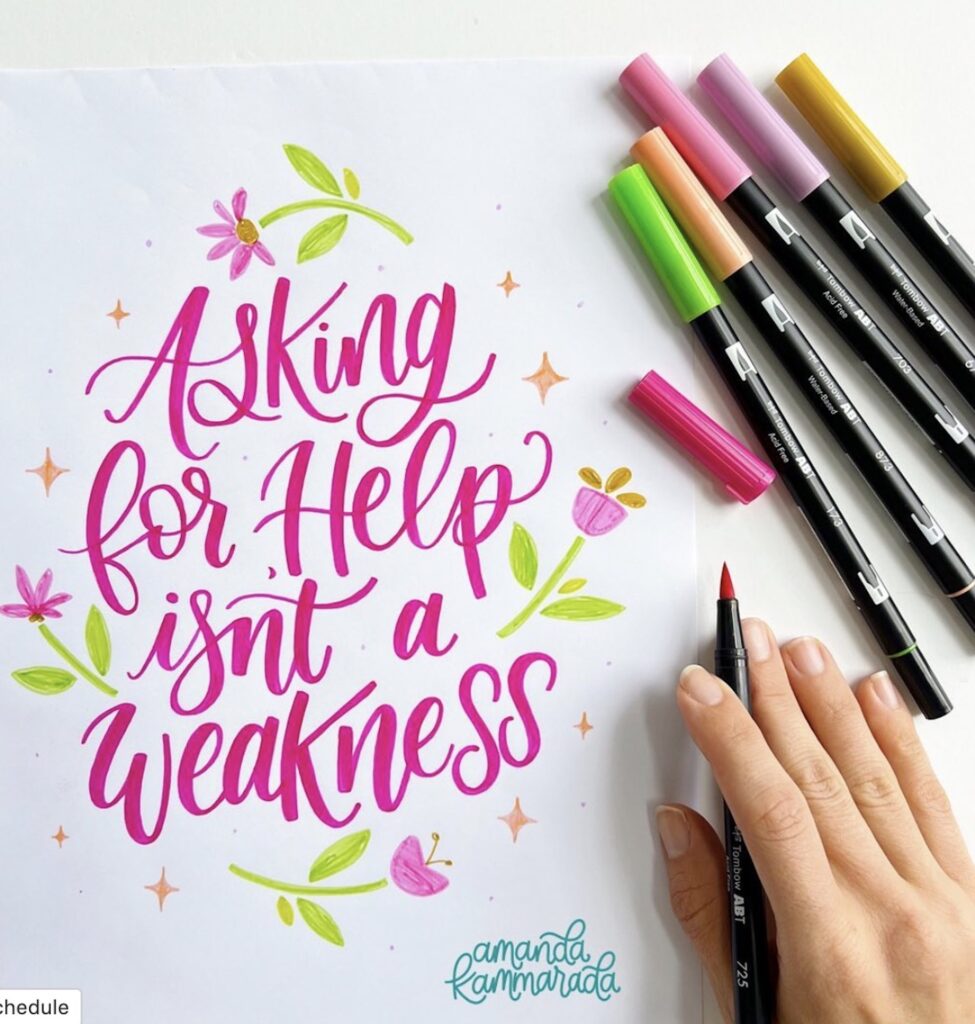
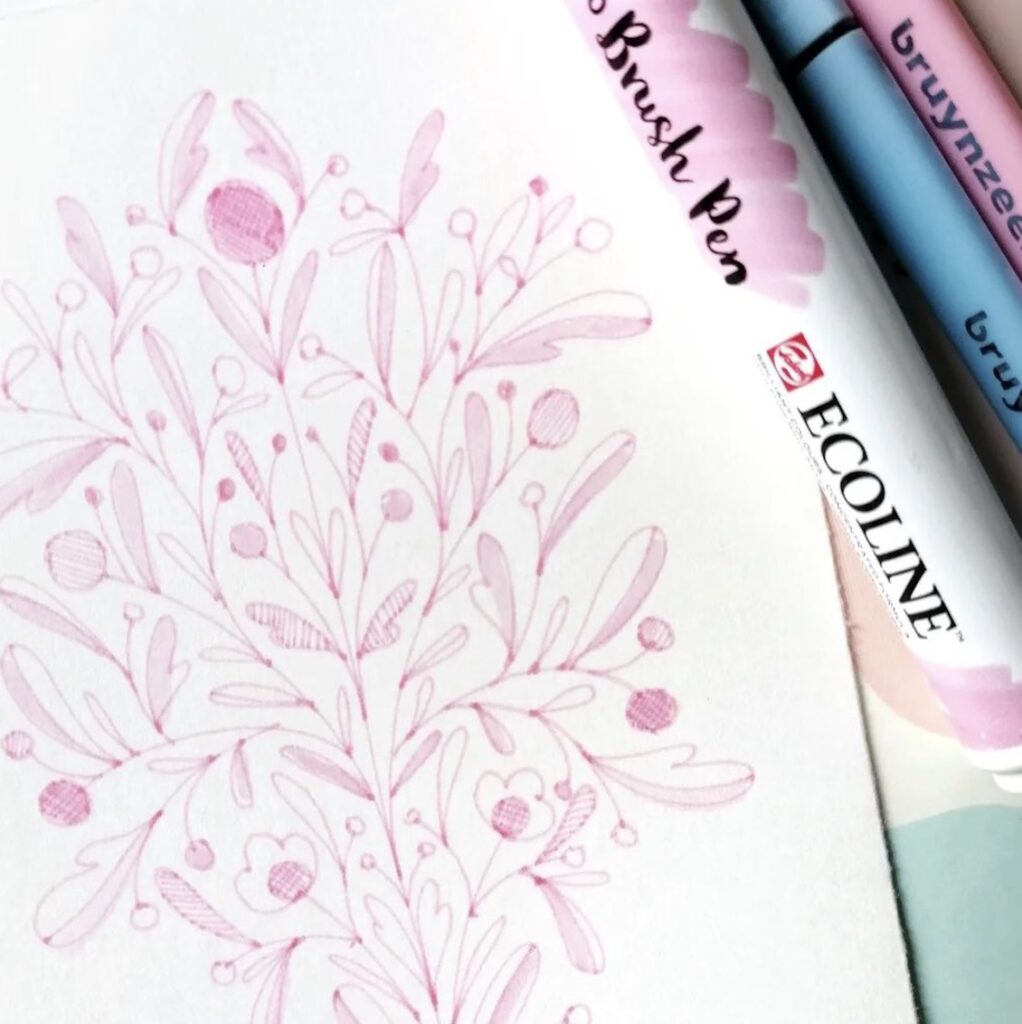
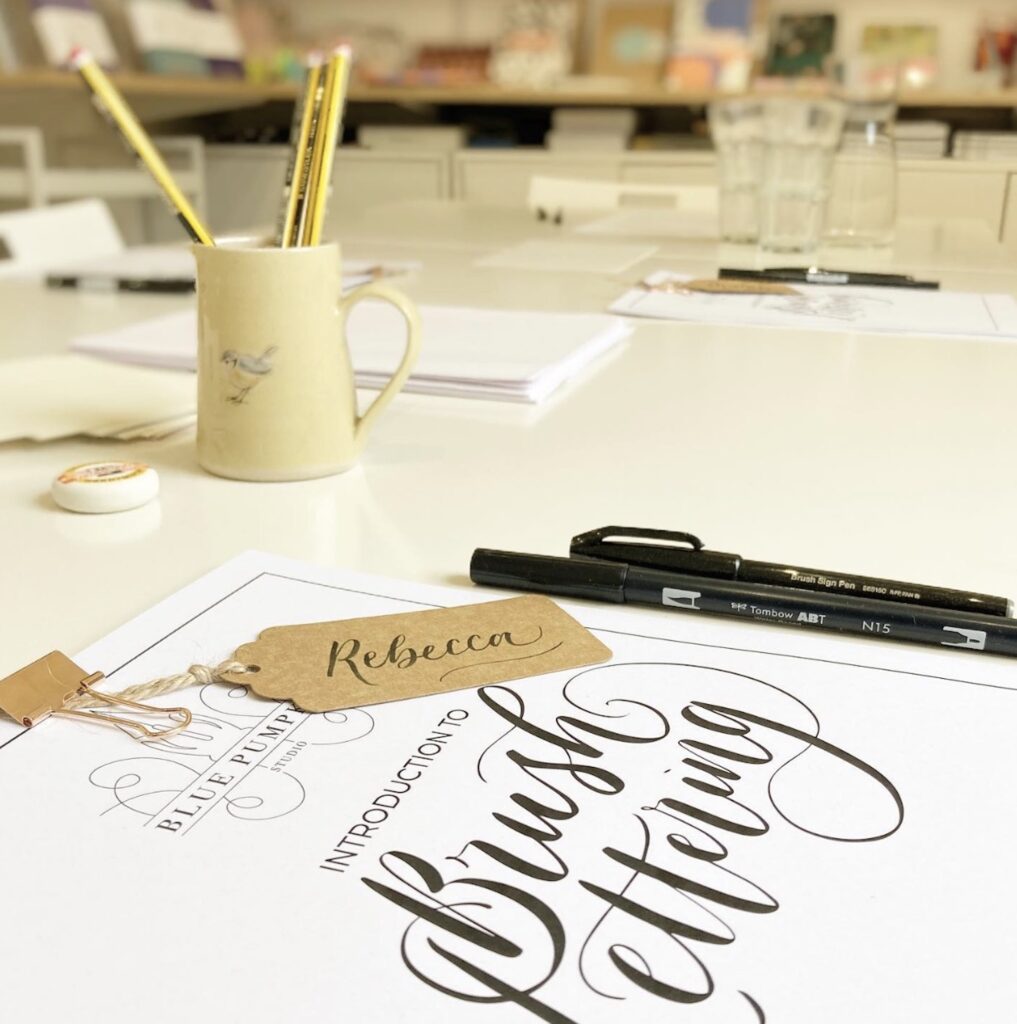
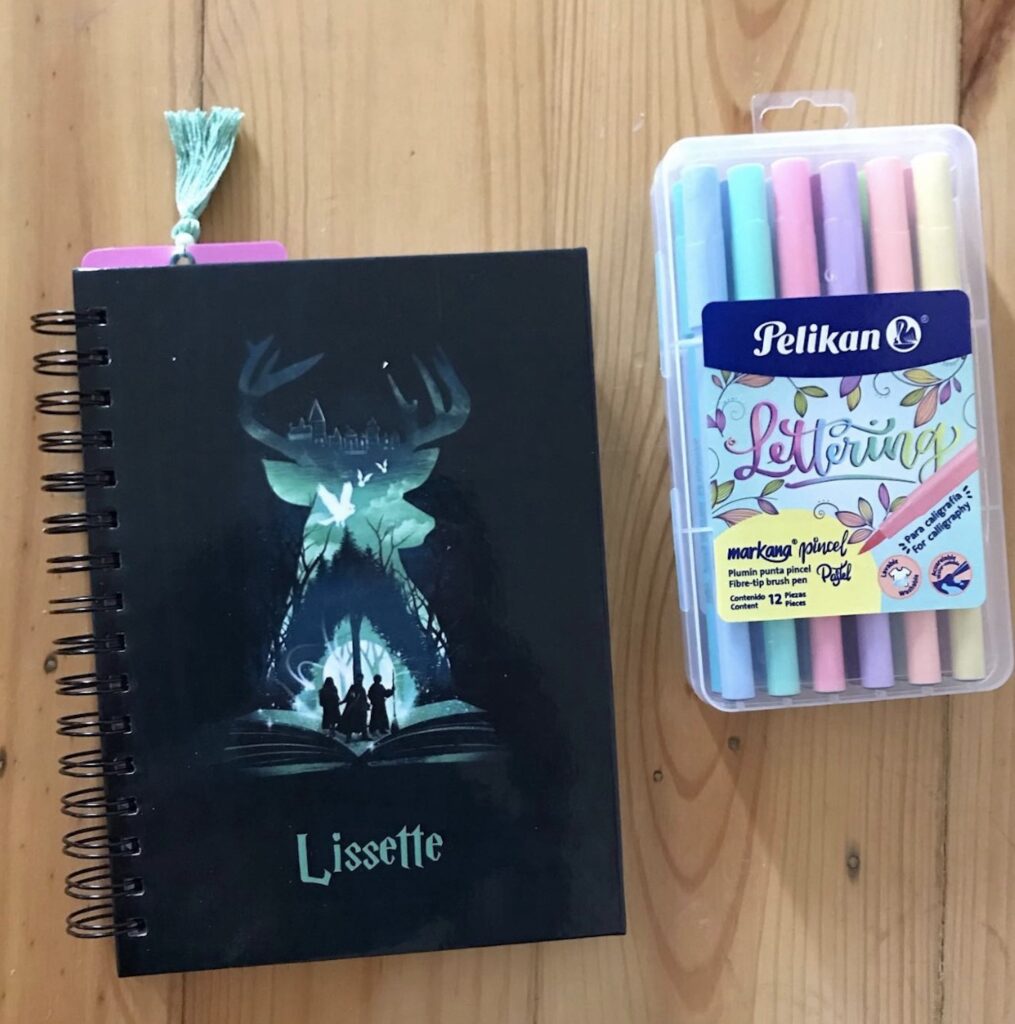
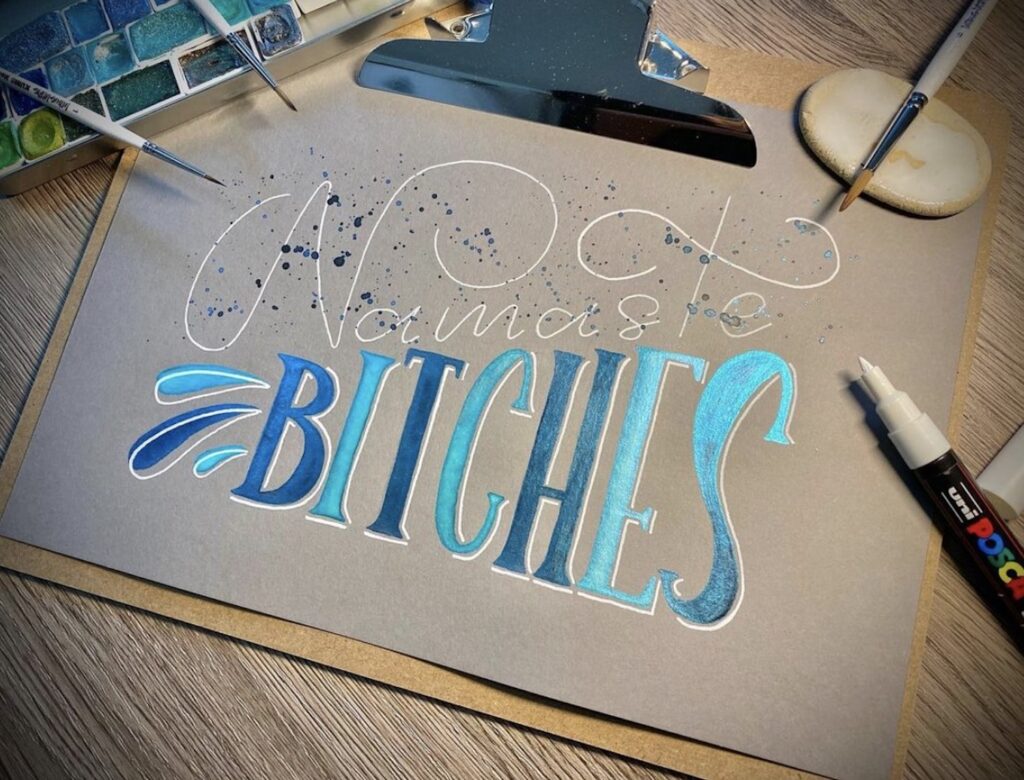

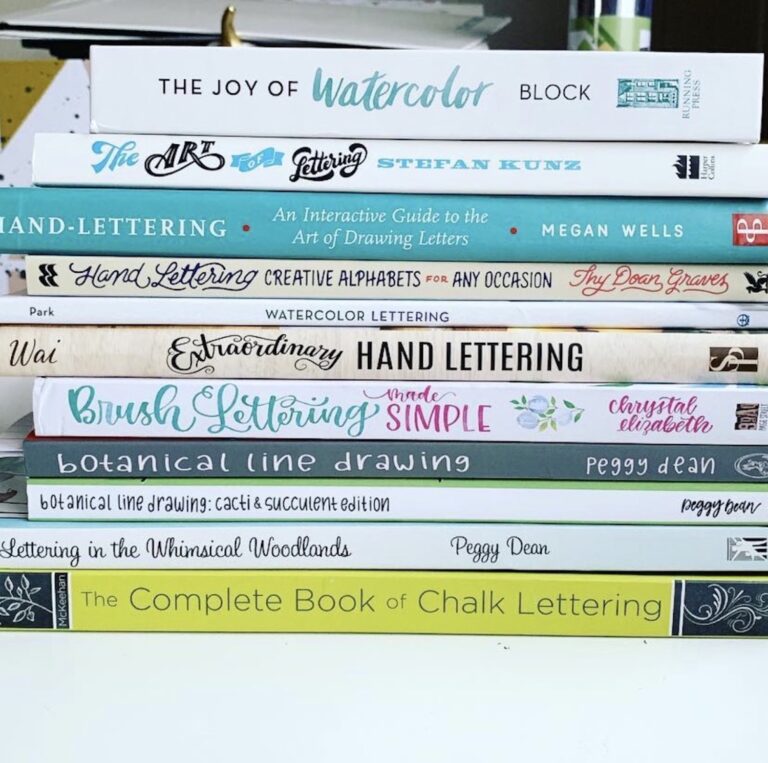
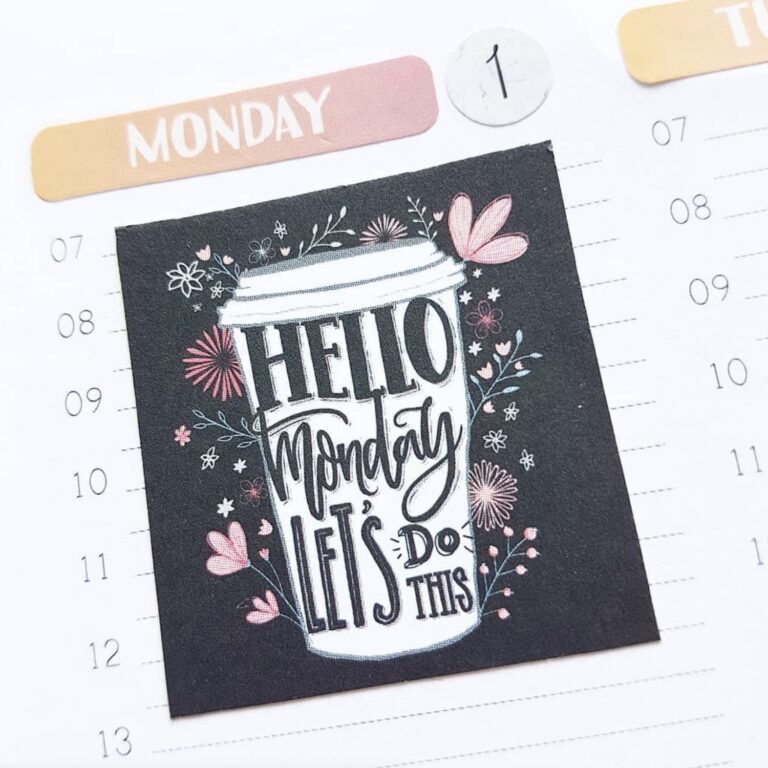
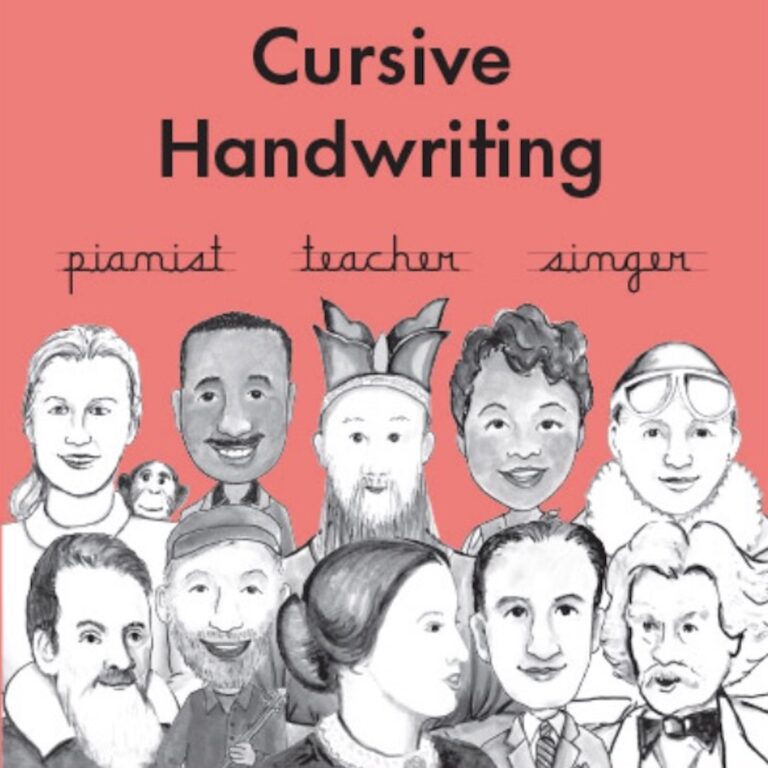

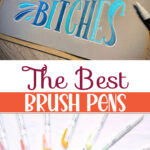
Kuretake is also a great brush pen. The natural sable brush tip allows me to create fine lines and finished strokes with ease. The tip’s fine bristles also give it the adaptability to create varied line widths, from very fine to broad.